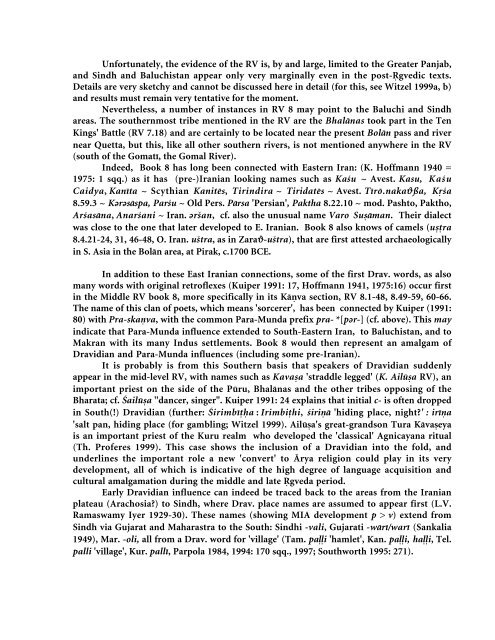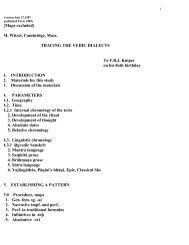The Languages of Harappa - People Fas Harvard
The Languages of Harappa - People Fas Harvard
The Languages of Harappa - People Fas Harvard
Create successful ePaper yourself
Turn your PDF publications into a flip-book with our unique Google optimized e-Paper software.
Unfortunately, the evidence <strong>of</strong> the RV is, by and large, limited to the Greater Panjab,<br />
and Sindh and Baluchistan appear only very marginally even in the post-gvedic texts.<br />
Details are very sketchy and cannot be discussed here in detail (for this, see Witzel 1999a, b)<br />
and results must remain very tentative for the moment.<br />
Nevertheless, a number <strong>of</strong> instances in RV 8 may point to the Baluchi and Sindh<br />
areas. <strong>The</strong> southernmost tribe mentioned in the RV are the Bhalånas took part in the Ten<br />
Kings' Battle (RV 7.18) and are certainly to be located near the present Bolån pass and river<br />
near Quetta, but this, like all other southern rivers, is not mentioned anywhere in the RV<br />
(south <strong>of</strong> the Gomatī, the Gomal River).<br />
Indeed, Book 8 has long been connected with Eastern Iran: (K. H<strong>of</strong>fmann 1940 =<br />
1975: 1 sqq.) as it has (pre-)Iranian looking names such as Kaśu ~ Avest. Kasu, Kaśu<br />
Caidya, Kanīta ~ Scythian Kanitẽs, Tirindira ~ Tiridatẽs ~ Avest. Tīrō.nakaθßa, Kśa<br />
8.59.3 ~ Kərəsåspa, Parśu ~ Old Pers. Pårsa 'Persian', Paktha 8.22.10 ~ mod. Pashto, Paktho,<br />
Arśasåna, Anarśani ~ Iran. əršan, cf. also the unusual name Varo Suåman. <strong>The</strong>ir dialect<br />
was close to the one that later developed to E. Iranian. Book 8 also knows <strong>of</strong> camels (ura<br />
8.4.21-24, 31, 46-48, O. Iran. uštra, as in Zaraθ-uštra), that are first attested archaeologically<br />
in S. Asia in the Bolån area, at Pirak, c.1700 BCE.<br />
In addition to these East Iranian connections, some <strong>of</strong> the first Drav. words, as also<br />
many words with original retr<strong>of</strong>lexes (Kuiper 1991: 17, H<strong>of</strong>fmann 1941, 1975:16) occur first<br />
in the Middle RV book 8, more specifically in its Kåva section, RV 8.1-48, 8.49-59, 60-66.<br />
<strong>The</strong> name <strong>of</strong> this clan <strong>of</strong> poets, which means 'sorcerer', has been connected by Kuiper (1991:<br />
80) with Pra-skava, with the common Para-Munda prefix pra- *[pər-] (cf. above). This may<br />
indicate that Para-Munda influence extended to South-Eastern Iran, to Baluchistan, and to<br />
Makran with its many Indus settlements. Book 8 would then represent an amalgam <strong>of</strong><br />
Dravidian and Para-Munda influences (including some pre-Iranian).<br />
It is probably is from this Southern basis that speakers <strong>of</strong> Dravidian suddenly<br />
appear in the mid-level RV, with names such as Kavaa 'straddle legged' (K. Ailūa RV), an<br />
important priest on the side <strong>of</strong> the Pūru, Bhalånas and the other tribes opposing <strong>of</strong> the<br />
Bharata; cf. Śailūa ''dancer, singer". Kuiper 1991: 24 explains that initial c- is <strong>of</strong>ten dropped<br />
in South(!) Dravidian (further: Śirimbīa : Irimbihi, śiriå 'hiding place, night?' : irīa<br />
'salt pan, hiding place (for gambling; Witzel 1999). Ailūa's great-grandson Tura Kåvaeya<br />
is an important priest <strong>of</strong> the Kuru realm who developed the 'classical' Agnicayana ritual<br />
(Th. Pr<strong>of</strong>eres 1999). This case shows the inclusion <strong>of</strong> a Dravidian into the fold, and<br />
underlines the important role a new 'convert' to Ārya religion could play in its very<br />
development, all <strong>of</strong> which is indicative <strong>of</strong> the high degree <strong>of</strong> language acquisition and<br />
cultural amalgamation during the middle and late gveda period.<br />
Early Dravidian influence can indeed be traced back to the areas from the Iranian<br />
plateau (Arachosia?) to Sindh, where Drav. place names are assumed to appear first (L.V.<br />
Ramaswamy Iyer 1929-30). <strong>The</strong>se names (showing MIA development p > v) extend from<br />
Sindh via Gujarat and Maharastra to the South: Sindhi -vali, Gujarati -wårī/warī (Sankalia<br />
1949), Mar. -oli, all from a Drav. word for 'village' (Tam. pai 'hamlet', Kan. pai, hai, Tel.<br />
palli 'village', Kur. pallī, Parpola 1984, 1994: 170 sqq., 1997; Southworth 1995: 271).

















